
Cross-education is the term given to the increase in strength, and potentially even size, of an opposite limb after training only one limb.
Table of Contents
For example, let’s say you trained only your left arm with dumbbell biceps curls for the next few months.
Before and after doing this, you test a one-rep max dumbbell biceps curl with your left arm and right arm. You also measure the size of both your biceps.
This left arm, the arm you trained, would of course experience increases in strength and size. However, despite not training the right arm, it will also likely experience some increases in strength and perhaps even some size.
This is cross-education. There are many other synonyms for cross-education, like the contralateral effect, cross-limb transfer, inter-limb transfer, bilateral transfer, and many others.
I’m sure many would be questioning the mechanisms behind cross-education. How is it possible that training ONLY one limb results in strength and potentially size gains in the opposite limb that you did not train?
We’ll explore the potential mechanisms a little later, but first, let us explore just how much strength and size gain we might expect with the cross-education effect.
Let’s first explore strength gains.
Cross-Education and Strength Gains
A meta-analysis by Manca et al. gives us an insight into this area.
By the way, meta-analyses are studies that combine the results of numerous individual studies.
31 studies were included in this meta-analysis. The average duration of these studies was around 5 and a half weeks. But they ranged from only 3 weeks to 12 weeks in duration. So keep this in mind when interpreting the results.
Based on the 31 studies, the untrained opposite limb (which could be the muscles of an arm or leg) experiences an 11.9% increase in strength.
Straight away we can see this is a meaningful strength increase.
But it would be useful to know the strength increase for the trained limb, as this would allow us to make comparisons between the two percentages.
Unfortunately, this meta-analysis did not report the average strength increase for the trained limb.
Nonetheless, from the 31 studies, I decided to go out and collect the percentage increases in strength for the trained limb.
Note that this isn’t exactly the way meta-analyses do it, there is a little more detail to it. But it should give us a rough idea of what we are after.
Out of the 31 studies, there were 5 studies I could not get the data from. This was either because I could not get access to the paper or because they did not report the strength increase for the trained limb.
From the 26 studies, on average, training one limb resulted in a 27.6% increase in strength for that limb.
Putting it all together, training one limb increases the strength of that limb by 27.6%, while that opposite limb you did not train at all experiences an 11.9% increase in strength.

We mustn’t get carried away with these numbers, as the 31 studies these numbers are from are quite divergent.
Some studies had participants train the muscles of one side of their upper body, others had participants train the muscles of one side of their lower body.
Contraction modes also varied. Some studies used typical exercises that involve concentric and eccentric phases, called isotonic exercises. Some used concentric only training, others with eccentric only training, and even some with isometric only training.
Fortunately, this meta-analysis included sub-analyses that looked at these various areas.
When isolating the studies that looked at training one side of the upper body, the trained side experienced a 24.3% increase in strength, while the untrained side experienced a 9.4% increase in strength.
When isolating the studies that looked at training one side of the lower body, the trained side experienced a 30.9% increase in strength, while the untrained side experienced a 16.4% increase in strength.
Note, the percentage increases given for the trained side is from my analysis detailed earlier, not the meta-analysis. Nevertheless, it’s apparent the cross-education effect is more pronounced with the lower body.
For contraction type, training one side of your body isometrically resulted in a 22.9% increase in isometric strength for that side. The untrained side experienced an 8.2% increase in isometric strength.
Training one side of your body concentrically resulted in an 11.3% increase in concentric strength for the untrained side of the body. Unfortunately, from the 26 studies I assessed, none looked at concentric only training, so I could not calculate the average increase for the trained limb.
Training one side of your body eccentrically resulted in a 17.7% increase in eccentric strength for the untrained side of your body. Unfortunately, from the 26 studies I assessed, only 3 looked at eccentric only training, and the percentage increase from each varied dramatically, meaning It was not sensible to average them out. Therefore, the trained limb increase could not be calculated.
Isotonic training resulted in a 15.9% increase in strength for the untrained limb. The trained side, based on my analysis, experienced a 33.1% increase in strength.
Overall, eccentrically overloading one side of your body results in relatively the greatest cross-education effect.
The meta-analysis also found somewhat of a correlation between the strength gained in the trained limb and the strength gained in the untrained limb. Implying that the greater strength gains you experience for your trained limb, the greater strength gain the untrained limb would experience.
Cross-Education and Muscle Size
Let’s now move on to muscle size.
Unfortunately, there are no meta-analyses looking at cross-education and muscle size.
But nonetheless, I went out and searched for as many studies as I could, assessing how training one limb can impact the size of the untrained opposite limb.
I found 11 studies. Of these, 4 found that the untrained limb did experience growth (Brown et al., Bezzera et al., Magnus et al., and Beyer et al.). But the remaining 7 found no growth of the untrained limb (Houston et al., Goodwill et al., Latella et al., Boyes et al., Fathling et al., Krotkiewski et al., and Young et al.).
Interestingly, of these 7 studies, 3 of them did not find growth of the trained limb either (Houston et al., Goodwill et al., and Latella et al.). In other words, the protocols used in these three studies were likely not sufficient to induce hypertrophy.
The other four studies did find the growth of the trained limb, but no growth of the untrained limb.
So, when looking at the current evidence, although some evidence suggests the untrained limb does not experience growth, we do have 4 studies suggesting growth may occur in an untrained limb.
Let us get a quick overview of these four studies, in hope of drawing some conclusions.
Brown et al. had 14 elderly untrained men perform unilateral elbow flexions, for 2-4 sets, three times per week for 12 weeks.
Cross-sectional area of the trained elbow flexors increased by 17.4%, while cross-sectional area of the untrained elbow flexors increased by 7.2%.
Bezzera et al. had 10 untrained subjects perform maximal isometric knee extensions with their right leg three times per week for 6 weeks.
Unfortunately, they did not provide the actual numbers, but they did present a graph. Looking at the graph, we can see that, as expected, the right leg experienced increases in quadriceps cross-sectional area. For the left leg, although it was not classified as statistically significant, we can still see there were slight increases in quadriceps cross-sectional area.

Magnus et al. split 23 untrained subjects into a training or control group. The training group trained one side of their body with a variety of shoulder exercises, three times per week for 4 weeks.
Thickness of the supraspinatus and anterior deltoid increased by a significant amount for the trained side. The untrained limb did not experience any supraspinatus growth, but there was some anterior deltoid growth despite it not being statistically significant.
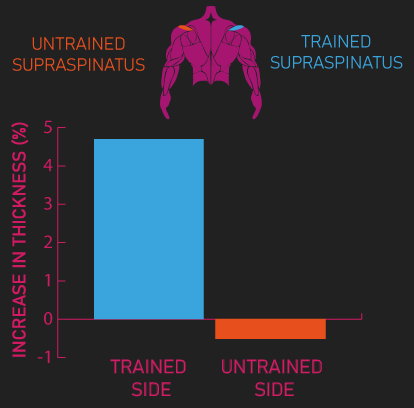
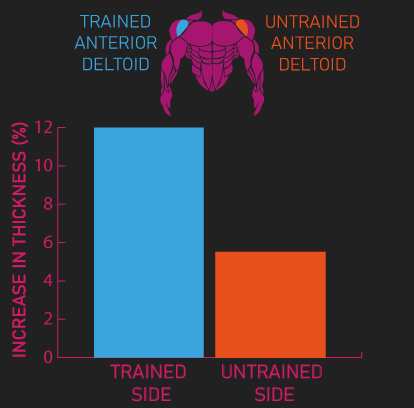
Beyer et al. split 17 untrained men into a training group or control group. The training group trained their dominant leg with the unilateral leg extensions for 3 sets, three times per week for 4 weeks.
Thickness as well as cross-sectional area, was measured for the vastus lateralis and rectus femoris. As expected, significant increases were observed for all measures done on the trained leg. For the untrained leg, although the increases were not statistically significant, we can see some increases in measurements. Mainly with the thickness and cross-sectional area of the vastus lateralis.
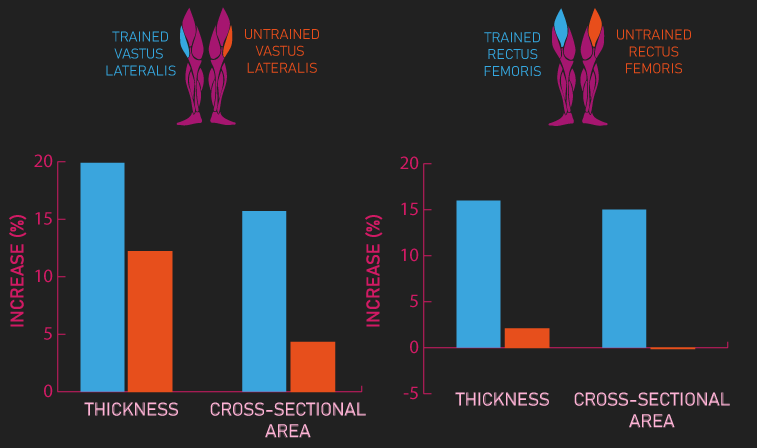
So, overall, we do have some evidence that an untrained limb can grow in response to training the opposite limb.
But, the amount of growth does not seem to be much, it only appears to be a slight increase in muscle size.
Moreover, the 4 studies were conducted on untrained individuals.
Although I could not find any research on trained individuals, I think it’s very likely they would experience smaller increases in muscle size, or perhaps even no growth with cross-education.
Before moving on, if you’re curious about creating an effective training program for muscle hypertrophy, our high quality partner Alpha Progression can help. It can generate a highly effective program for you, track your workouts live with in-built progression recommendations, provide graphs displaying your long term progress, and it has a massive exercise database with more than 550 exercises.
Click HERE (the link opens in a new tab) to get a free 2 week trial of the apps features. If you like it and go beyond, the link also gives you 20% off a subscription!
We never promote trash at the House of Hypertrophy, so rest assured the app is high quality. The reviews speak to this, 4.8 starts (based on more than 7,000 reviews) on Google play, and 4.9 stars in Apple’s store (based on nearly 400 ratings).
Cross-Education and Immobilization
One of the real-world applications of the cross-education effect is when you injure one side of your body. If your injury is severe enough, it may need to be put in a cast, meaning it is immobilized.
Immobilizing a limb for an extended period often results in strength and size decreases for the muscles in that immobilized limb.
Training the limb that is not immobilized can help attenuate any strength and size loss that may have occurred in the opposite immobilized limb, thanks to the cross-education effect.

None of the studies we have looked at so far in this video had participants immobilize their untrained limb, in all of the studies, participants continued using their untrained limb in normal life.
Nevertheless, there do exist studies investigating the cross-education effect when the opposite untrained limb is put in a cast.
A review paper by Andrushko et al. assessed the research in this area.
5 studies have investigated how training one arm can impact the strength and size of an opposite immobilized arm. All 5 of these studies also had a control group for comparison purposes. These control groups had one arm immobilized, but they did not train either of their arms.
Note, I am indeed saying arm. As far as I’m aware, there are no studies assessing the effects of cross-education when one leg is immobilized.
Strength Gains
Let’s first look at strength.
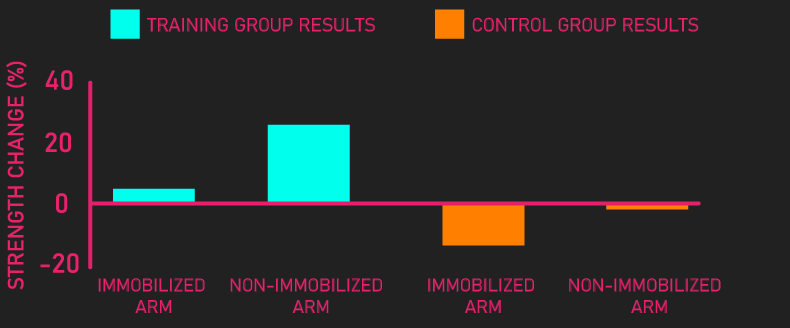
When averaging out the 5 studies, the training groups experienced a 26% increase in strength for the trained arm. For the opposite immobilized untrained arm, they experienced a 4.6% increase in strength.
The control groups, on average, experienced a 2.5% decrease in strength for their non-immobilized arm and a 13.3% decrease for their immobilized arm.
Therefore, cross-education not only attenuated strength loss for the immobilized arm but actually also helped to increase strength.
Now, these 5 studies were conducted on untrained individuals. I think it’s highly likely that if they were well trained, cross-education probably would not increase strength. But it likely would go some way to attenuating any strength loss with immobilization.
Muscle Size
Moving on to muscle size, the training groups experienced a 3.9% increase in size for the trained arm and a 0.2% increase in size for the opposite untrained immobilized arm.
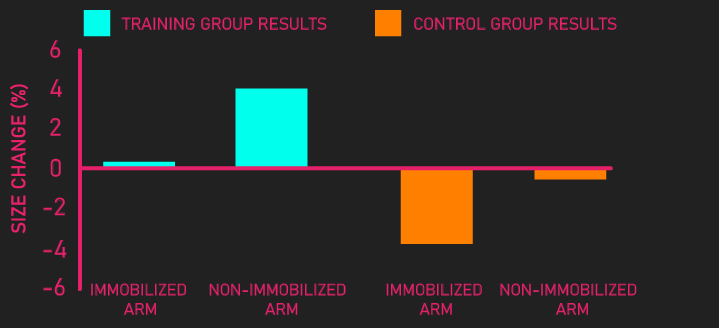
The control groups experienced a 0.6% decrease in size for the non-immobilized arm, while their immobilized arm decreased in size by 3.8%.
Therefore, training one arm was effective as pretty much maintaining the size of the opposite immobilized arm.
Again, remember, the subjects were untrained. With trained subjects, I’m not sure if training one limb would be effective at maintaining the muscle mass of an immobilized limb. but it probably would go some way to minimizing decreases in muscle size.
Mechanisms Behind Cross-Education
Okay, let’s now explore the potential mechanisms behind the cross-education effect.
Muscle Size
Let us start with muscle size.
There are two hypotheses I’ve come across. The first hypothesis relates to hormones, the second relates to mirror activity.
Let’s explore the first hypothesis.
Muscle growth can simply be thought of as a result of muscle protein synthesis exceeding muscle protein breakdown over time.
At the cellular level, an increase in protein synthesis, as well as a decrease in protein breakdown, is a result of various signaling pathways.
Signaling pathways are where various proteins interact in a chain-reaction fashion, and in our case, would result in the synthesis of proteins. Or more simply, the creation of the proteins that make our muscles bigger.
Moreover, some proteins, as part of signaling pathways, can inhibit the activation of other proteins. For example, one protein may inhibit a protein that is involved in protein breakdown.
One particular pathway involved in muscle hypertrophy is the PI3K/AKT/mTOR pathway.
A protein called PI3K activates a protein called Akt. Akt then activates mTORc1 which is a protein complex. mTORc1 can activate S6K1. S6K1 then initiates protein synthesis in ribosomes. Ribosomes can be considered the factory in which proteins are created.
This particular pathway can also decrease protein breakdown. Akt is thought to inhibit FOXO proteins. These FOXO proteins are involved in protein breakdown.
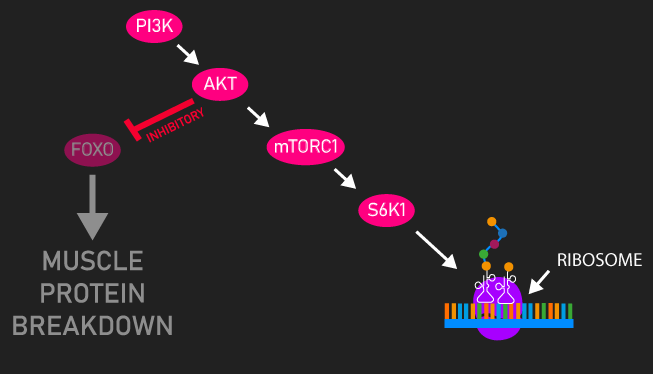
I should note this is a fairly simplified view of this pathway. But for this video, it will suffice.
So, how are signaling pathways initiated?
One way is through hormones.
Lifting weights temporarily elevates the levels of various anabolic hormones, such as growth hormone, IGF-1, and testosterone.
Growth hormone is believed to primarily exert its anabolic effects through its stimulation of IGF-1 production from the liver. IGF-1 binds to IGF-1 receptors on the membrane of muscle fibers. This binding initiates the PI3K/AKT/mTOR pathway.
Similarly, I’ve come across evidence suggesting testosterone could play a role in initiating this pathway too, through a binding to a different receptor. Also, testosterone is thought to bind to androgen receptors within the muscle fiber. This event is also thought to play a role in stimulating muscle growth.
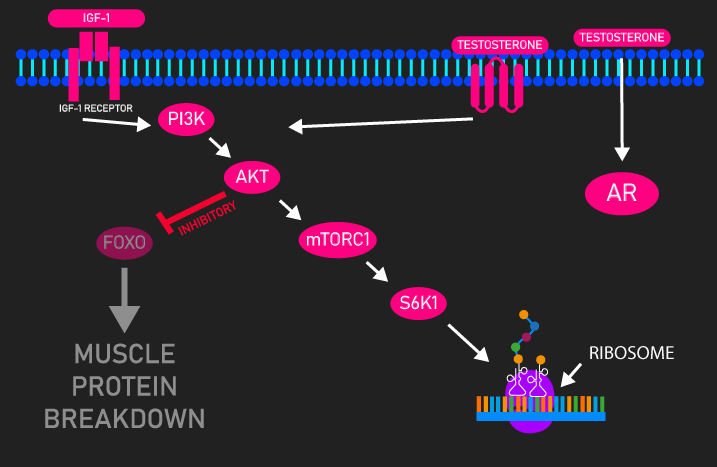
When performing unilateral resistance training, these anabolic hormones could be released into circulation and they could potentially, through the events just discussed, induce growth in the opposite untrained limb.
However, there are noteworthy limitations to this proposed mechanism.
Multi-joint exercises, that involve large amounts of muscle mass result in the circulation of those anabolic hormones.
Single-joint exercises, such as the ones that would be used during unilateral training in hope of eliciting to cross-education effect, hardly, if at all, result in the circulation of anabolic hormones.
Moreover, even if unilateral single-joint exercises did result in the circulation of anabolic hormones, there does not appear to be much of a correlation between acute hormonal responses and muscle hypertrophy.
Meaning that despite the logical rationale behind why exercise-induced elevations in anabolic hormones may contribute to growth, the weight of the current evidence suggests that training programs that elicit high elevations of those various anabolic hormones hardly, if at all, produce greater muscle growth than training programs that do not elicit elevations in anabolic hormones.
On to the second hypothesis.
Mirror activity refers to the phenomena that during unilateral resistance training, the corresponding opposite muscle not being trained experiences slight activation.
Magnus et al. found that during isometric training for one biceps brachii, the opposite biceps brachii not being trained (which was immobilized) was activated at 3.1% of the biceps brachii being trained.
Similarly, during isometric training for the triceps brachii, the opposite triceps brachii not being trained (which was immobilized) was activated at 6.1% of the triceps brachii being trained.
Another study by Andrushko et al. found that during unilateral wrist flexor training, the opposite wrist flexors not being trained (which was immobilized) were activated at 5.6% of its maximum voluntary contraction.
So, there does seem to be something going on during unilateral training that results in the opposite limb experiencing some activation.
However, it is very slight, and I’m not sure this level of activation would even be sufficient to induce muscle growth.
During everyday life, people probably experience this level of activation or even slightly more of numerous muscles during simple tasks. But of course, these events do not usually result in hypertrophy.
Ultimately, both hypotheses have their limitations, but I don’t think we can completely rule both of them out.
More research would be needed in this area.
Strength Gains
What about the mechanisms behind the increases in strength of an untrained limb?
As established, although the untrained limb could increase in size, the growth isn’t significant. Therefore, muscle growth probably cannot explain a large part of the significant strength gain observed in that untrained limb.
Accordingly, adaptations in the central nervous system (which is the brain and spinal cord) likely explain this.
To understand these potential adaptations, we first need a basic understanding of how the nervous system interacts with your muscles.
The reason muscles contract is because they receive electrical signals that originate from the brain. There are two neurons (also called nerve cells) in this system, an upper motor neuron, and a lower motor neuron.
Upper motor neurons originate in the cerebrum (which are the hemispheres of the brain), and mostly end at a particular region in the spinal cord. Lower motor neurons mostly originate from the spinal cord and end at a muscle.
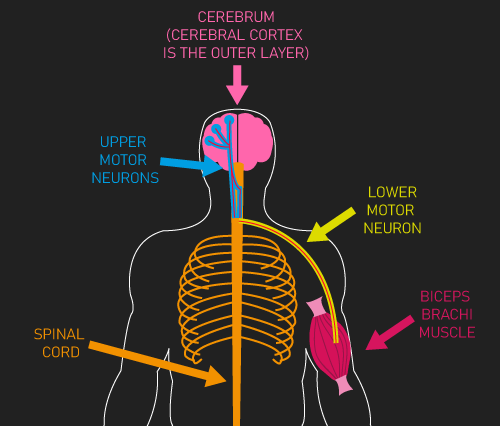
As just mentioned, the cerebrum consists of two hemispheres. The right hemisphere controls the muscles of the left side of the body, while the left hemisphere controls the muscles of the right side of their body
Let’s look at the simplified events of contracting your left bicep.
Upper motor neurons, originating in the right hemisphere of the cerebrum, send an electrical signal down its length. At an area where the medulla is located, some upper motor neurons, cross over to the opposite side of the body. Other upper motor neurons continue down the same side.
At the spinal cord, regardless of whether the upper motor neurons crossed over, they can transmit the electrical signal to lower motor neurons.
Once these lower motor neurons get sufficiently excited, they send the electrical signals down their length and transmit the signal to the muscle they innervate. Which in our example is the left bicep. The electrical signal within the bicep ultimately causes it to contract.
The upper and lower motor neurons have names.
The fibers of the numerous upper motor neurons that come down from the cerebrum are collectively known as the corticospinal tract.
Cortico refers to the cerebral cortex, this is the outer layer of the cerebrum, which is the location of where the upper motor neurons originate. Spinal, of course, refers to the spine, which is where upper motor neurons mostly end.
The lower motor neurons that receive signals from the corticospinal tract, and subsequently transmit these signals to contracting muscle fibers are called alpha motor neurons.
As established, the corticospinal tract originates in the cerebral cortex.
Ultimately, there are numerous regions of the cerebral cortex that play a role in causing muscle contraction.
A review paper by Frazer et al. suggests that the dorsal premotor cortex, supplementary motor area, and cingulate cortex on one side of the cerebral cortex have strong connections to the homologous zone on the opposite cerebral cortex.
Meaning there are connections between the right and left dorsal premotor cortex, connections between the right and left supplementary motor area, and connections between the right and left cingulate cortex.

Remember, when training only one side of your body, one hemisphere of your cerebrum, and therefore cerebral cortex would be active.
Adaptations that occur in the activated regions of one hemisphere, particularly the regions just discussed, could be somewhat transferred to the opposite hemisphere through the existing connections.
This transference of adaptations to the untrained hemisphere, which controls the opposite untrained limb, could somehow result in increased strength of that limb.
Another potential mechanism behind the strength gain of an untrained limb relates to increased excitability or decreased inhibition of the corticospinal tract associated with that untrained limb.
To understand what this means, we first need to understand the structure of a neuron. Remember, numerous upper motor neuron fibers make up the corticospinal tract.
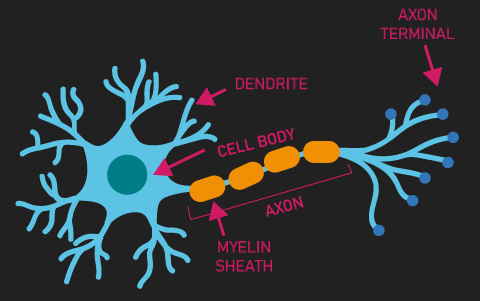
A neuron has a cell body, from which dendrites are an extension. These dendrites are primarily responsible for receiving signals from other neurons.
One neuron receives many signals from many neurons. If most of the signals a neuron receives are inhibitory, then the likelihood of the neuron generating an electrical signal is low. Conversely, if most of the signals a neuron receives are excitatory, an electrical signal will then likely be generated. This signal is transmitted along the axon.
On the axon, there are structures called myelin sheaths. They allow the electrical signals to travel along the neuron quicker. As we continue along the neuron, we can see the axon branches out. These branches are called axon terminals. The axon terminals essentially transmit the electrical signal to other neurons.
An increase in corticospinal excitability would mainly imply that the neurons making up the corticospinal tract receive more excitatory signals from the neurons they communicate with.
This means the muscle this corticospinal tract is associated with (which in our case is an untrained muscle) will receive more signals, resulting in greater muscle contraction (which is the same thing as saying it is now stronger).
Although there is evidence finding an increase in corticospinal excitability with cross-education, as noted in the review paper by Frazer et al., there are numerous papers finding no effect on corticospinal excitability with cross-education.
There actually seems to be stronger evidence supporting a decrease in corticospinal inhibition.
A decrease in corticospinal inhibition would imply that the neurons making up the corticospinal tract would experience less inhibitory signals from the neurons near their dendrites. This decreased inhibition would make it more likely for the neurons to fire an electrical signal, ultimately resulting in more signals to that untrained muscle, meaning it is stronger.
The last potential mechanism we will look at relates to interhemispheric inhibition.
Interhemispheric inhibition refers to the phenomena where one cerebral hemisphere inhibits the opposite cerebral hemisphere.
One study found that an increase in strength of an untrained limb was accompanied by a 31% decrease in interhemispheric inhibition from the trained hemisphere to the untrained hemisphere.
This would imply that the untrained hemisphere, as a result of the decreased inhibition from the other trained hemisphere, would be able to transmit more electrical signals that ultimately end up at the untrained muscle.
Though, there are also studies finding no impact on interhemispheric inhibition with cross-education.
At the end of the day, despite the potential mechanisms behind the strength increase of an untrained limb being more studied than the hypertrophy increases of an untrained limb, more research is still very much required to fully understand the mechanisms behind it.
Remember to feel free to check out the Alpha Progression App if you’re interested. Also feel free to check out our free bench press e-book below.

